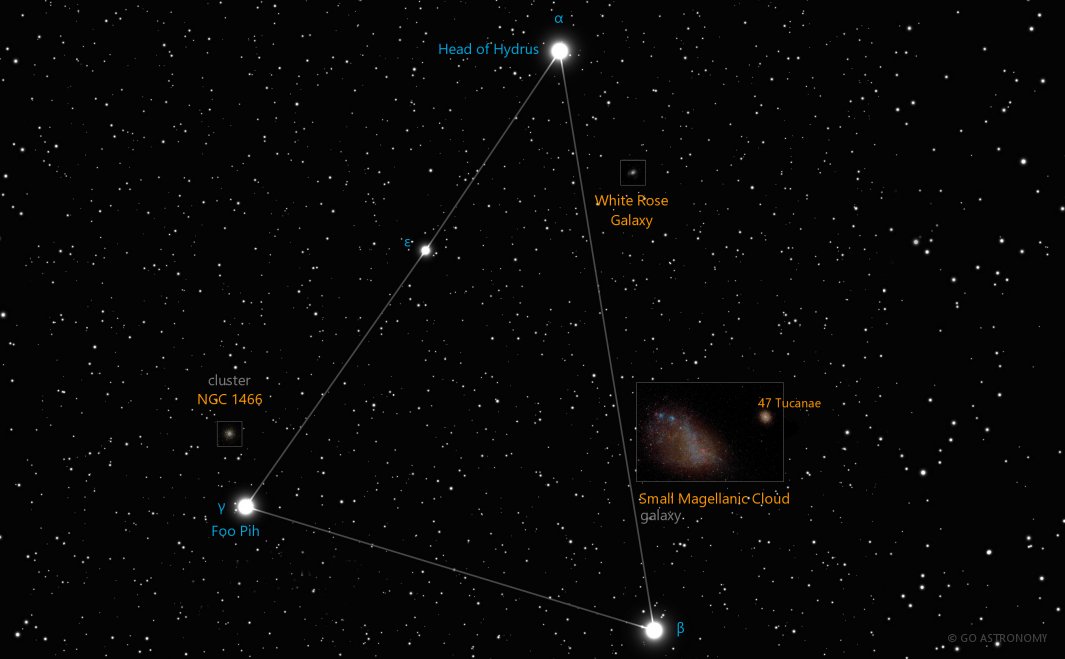Hydrus, the Water Snake (Hyi)
(HIGH-drus)
The Southern constellation of Hydrus, the Water Snake, is best viewed in Winter during the month of December.
Hydrus is the 61st largest constellation. It's brightest star is Beta Hydri at magnitude 2.82. The boundary of the Hydrus constellation contains 5 stars that host known exoplanets.
Hydrus is a circumpolar constellation, so is visible year-round in the Southern hemisphere. Conversely, it is not visible in the opposite hemisphere.
- Pronunciation:
- HIGH-drus
- Meaning:
- Water Snake
- Genitive:
- Hydri
- Abbreviation:
- Hyi
- Constellation Family:
- Hercules
- Hemisphere:
- Southern
- Quadrant:
- SQ1
- Visibility:
- 8° N - 90° S
- Best viewing month*:
- December
- Area:
- 243 sq. degrees
- Size:
- 61st largest
- Circumpolar** (N=northern, S=southern):
- S circumpolar
- Right Ascension (avg):
- 2h
- Declination (avg):
- -71°
- Brightest star:
- Beta Hydri (2.82)
- Stars with planets:
- 5
- Messier objects:
- |
- Caldwell objects:
- |
Brightest Stars in Hydrus
The 10 brightest stars in the constellation Hydrus by magnitude.
- Star
- Magnitude
- Spectral class
- Beta Hydri (β Hyi)
- 2.79
- G2IV
- Alpha Hydri (α Hyi)
- 2.86
- F0V
- Gamma Hydri (γ Hyi)
- 3.26
- M2III
- Delta Hydri (δ Hyi)
- 4.08
- A3V
- Epsilon Hydri (ε Hyi)
- 4.12
- B9III
- Eta Hydri (η2 Hyi)
- 4.68
- G5III
- Nu Hydri (ν Hyi)
- 4.76
- K3III
- Zeta Hydri (ζ Hyi)
- 4.83
- A2IV/V
- Lambda Hydri (λ Hyi)
- 5.09
- K5III
- Mu Hydri (μ Hyi)
- 5.27
- G4III
Galaxies in Hydrus
The most notable galaxies in the constellation Hydrus. Also see all galaxies.
The Water Snake Constellation
Hydrus, Latin for 'water snake', is a small constellation in the southern sky. While it shares part of its name and some mythological roots with Hydra, the two are separate entities, with Hydrus being the 'lesser' water snake. Named by Dutch navigators in the late 16th century, it is one of twelve constellations created by Dutch astronomer Petrus Plancius.
Historical Overview
Hydrus was one of the constellations introduced by Petrus Plancius from the observations of Dutch navigators Pieter Dirkszoon Keyser and Frederick de Houtman. It first appeared in a celestial globe published by Plancius in 1597, and was later included in Johann Bayer's star atlas Uranometria in 1603. Unlike most constellations, Hydrus doesn?t have roots in Greek or Roman mythology and does not have any myths associated with it.
Location and Main Features
Located in the southern sky's first quadrant (SQ1), Hydrus is visible at latitudes between +8? and -90?. Its neighboring constellations are Dorado, Eridanus, Horologium, Mensa, Octans, Phoenix, Reticulum, and Tucana. Hydrus spans only about 243 square degrees, making it the 61st largest constellation in terms of size.
Major Stars
Despite its small size, Hydrus hosts several notable stars. The brightest star in Hydrus is Beta Hydri, an evolved G-type star about 24 light-years away from Earth, with an apparent magnitude of 2.8. Beta Hydri is the nearest reasonably bright star to the South Celestial Pole.
The second-brightest star, Alpha Hydri, is a spectral type F0V main sequence star, somewhat hotter and more luminous than our Sun. Gamma Hydri, a red giant of spectral type M2 III located approximately 214 light-years from Earth, also stands out in this constellation.
Deep Sky Objects
Hydrus contains a few notable deep-sky objects. The constellation is home to the Hydrus Cluster (Abell 2877), an unusual galaxy cluster notable for containing a 'cold spot' in the cosmic microwave background. IC 1717 is another notable deep sky object in Hydrus; it's a spiral galaxy with an apparent magnitude of 12.9. There are also several notable double stars within Hydrus, including HD 10180, a sun-like star that hosts a system of seven confirmed exoplanets.
Observation
Hydrus is visible in its entirety from locations south of the equator, and can be seen in parts from southern and eastern South America, southern Africa, and northern Australia during the months of November to January. Although it is small and faint, its brightest stars form a recognizable pattern that resembles a snake, making it easier to spot in the southern night sky.
Hydrus in Modern Astronomy
In modern astronomy, Hydrus is relevant for the research conducted on the star HD 10180 and its planetary system. The discovery of seven planets around this star is significant as it represents one of the largest known planetary systems as of my knowledge cutoff in 2021. This system is the subject of ongoing study to understand planetary system formation and dynamics, contributing valuable knowledge to the field of exoplanet research.
While Hydrus might not have the fame or mythology associated with many northern constellations, its unique deep-sky objects and the presence of a rich planetary system make it an interesting field of study for both amateur and professional astronomers.
* Constellation shown for northen hemisphere skies. For the southern hemisphere, constellations appear rotated 180 degrees (upside-down and left-right reversed) from what is shown. Remember that seasons are reversed too - summer in northern latitudes is winter in southern latitudes.
** Circumpolar constellations are visible year-round in the hemisphere listed (and not at all in the opposite hemisphere).





